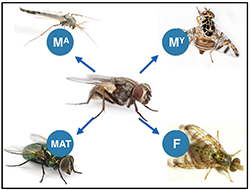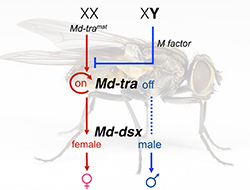Evolution of sex determining mechanisms
The existence of different sex-determining mechanisms in natural populations of Musca domestica makes the housefly a particularly suited system for studying evolutionary changes in sex determination pathways. We believe that these variations reflect minor changes in an otherwise well conserved pathway. By identifying the genes in the Musca pathway, we aim at an understanding of the principles of the underlying genetic control and, by comparison with sex determining genes in other species, of how such pathways evolve. These studies will not only increase our understanding of evolutionary plasticity in a fundamental developmental process but also have the potential to pave the road to novel genetic applications for controlling pest insect species.

The Musca model nicely recapitulates the diversity of sex determining strategies observed in different fly species. Like the Mediterranean fruit fly males can be heterogametic with a male determiner M on the Y-chromosome MY. This M can also be present on an autosome as in the harlequin fly (MA). It is believed that M carrying autosomes represent an early stage in the evolution of new Y chromosomes. In some housefly populations sex is determined by a dominant female determiner (F) rather than by M. This system resembles that of the one used in Chrysotrypanea, a fruit fly related to the Mediterranean fruit fly. Lastly, we discovered a strain which operates on a maternal system (MAT) in which females, depending on their genotype, produce only males or only females.
A similar maternal system is found in the hairy maggot blow fly. Hence, this rich diversity of sex determination systems within a single species provides an unprecedented opportunity to experimentally investigate the drivers and consequences of the evolution of sex determination.
With the molecular characterization of the male determiner M in Musca we have reached a major milestone in our research, namely a complete inventory of all major components of the Musca sex determination pathway (Sharma et al. 2017 Science). This provides an excellent starting point to investigate the molecular basis for diversity in this fundamentally important pathway.

Studies in a representative selection of holometabolous insects suggest the existence of a common logic of how sex is determined. There is an instructive signal at the top which is relayed by a short transductory module to set the sex-specific mode of the effector gene at the bottom of the pathway. Despite diversity at the instructive level, the signal-relaying part of the sex-determining pathway is remarkably well conserved. In principle, it is composed of the transformer gene (Md-tra in Musca), which acts as a conserved binary switch that transduces the selected sexual fate, female when ON, male when OFF, to the downstream effector doublesex (Md-dsx in Musca) that controls overt sexual differentiation. An interesting recurrent feature is that transformer is switched ON in the early zygote by maternally provisioned transformer activity (Md-tramat).
Different male-determining signals evolved, which prevent maternal activation of zygotic transformer to allow for male development. In Musca activation of this self-sustaining loop is prevented by the Mdmd gene which is the first male (M) factor identified in higher dipterans.
| Key Publications | |
| Sharma et al, 2017 Science | Link |
| Bopp et al, 2014 Sex Dev | Link |
| Hediger et al. 2010 Genetics | Link |
| Bopp 2010 J of Genet | Link |
| “Pregnant” Housefly Males Demonstrate the Evolution of Sex Determination | |